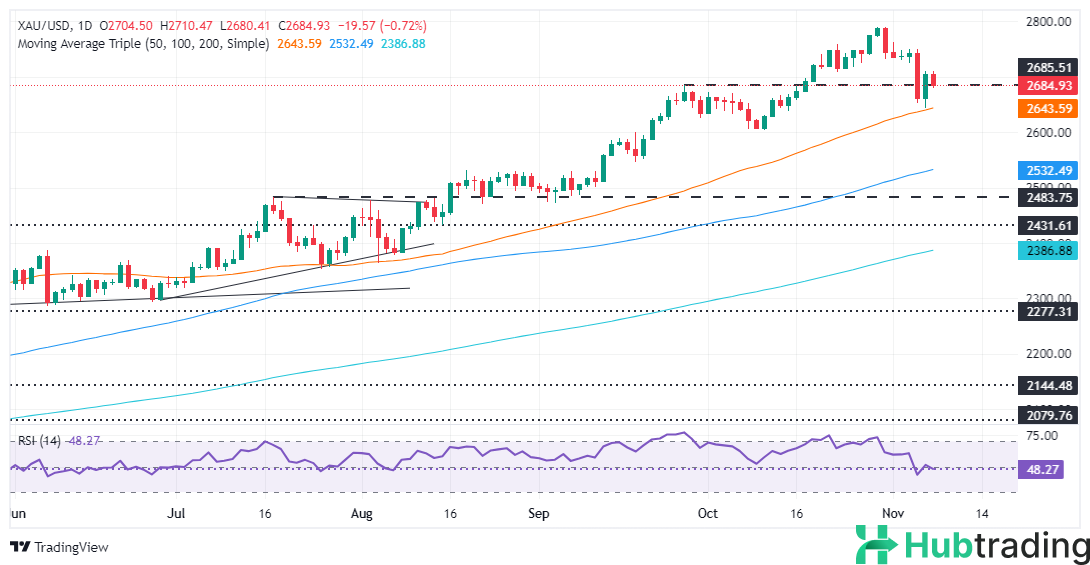- Gold falls as Trump’s win lowers political risk, shifting focus to potential inflationary policies.
- A US Dollar rebound weighs on bullion, despite lower Treasury yields.
- Powell hints at gradual rate adjustments, leaving the Fed’s future stance uncertain amid ongoing economic strength.
Gold prices declined on Friday as the US Dollar rebounded, despite falling US Treasury yields. Traders continued to digest Donald Trump’s election victory, scaling back their positions on the so-called "Trump trade" amid uncertainty over tariff policies. As of now, XAU/USD trades at $2,688, down more than 0.67%.
US equities extended their gains, brushing off election-related uncertainties that had previously driven bullion prices higher. With political risks easing, market participants are now focusing on Trump’s policy plans, particularly regarding inflationary pressures.
Following Trump's victory, the US Dollar strengthened, even as investors anticipate a less dovish stance from the Federal Reserve. Some of Trump's policies are seen as inflationary, which could put pressure on the Fed’s monetary policy.
On Thursday, the Federal Reserve lowered interest rates, acknowledging a strong economy and a cooling labor market. Despite signs of disinflation, officials noted that inflation "remains somewhat elevated" and still slightly above the 2% target. Fed Chair Jerome Powell provided little forward guidance on future rate moves but emphasized that the central bank can afford to take a cautious approach given the strength of the economy. He also noted that policy remains restrictive, even after the recent rate cut, as the Fed works to bring rates to neutral levels.
In addition to the Fed's actions, the US economic calendar saw the release of the University of Michigan (UoM) Consumer Sentiment for November, which surpassed expectations, rising to 73.0 from 70.5 in October. The report revealed mixed views on inflation expectations, with one-year inflation expectations slightly decreasing to 2.6%, while the five-year outlook ticked up to 3.1%.
Looking ahead, next week’s US economic data, including comments from Federal Reserve officials and key inflation reports, will likely influence gold's direction. Traders will be focused on consumer and producer inflation figures, along with retail sales data.
Daily Digest: Gold Price Slips as US Data Boosts US Dollar
- Gold prices retreated as US real yields— which typically move inversely to bullion—rose by two basis points to 1.978%.
- The US Dollar Index (DXY), which tracks the dollar against a basket of six major currencies, rallied 0.70% to 105.09 on Friday, adding further pressure on gold. Meanwhile, US Treasury yields, including the 10-year benchmark, fell by two basis points to 4.30%.
- The preliminary November University of Michigan Consumer Sentiment report showed a 3.5% increase, rising from 70.5 to 73.0. The report revealed that while current conditions showed little change, expectations surged to their highest level since July 2021.
- Inflation expectations also showed mixed signals, with one-year inflation expectations falling slightly to 2.6%, while the five-year outlook edged up to 3.1%.
- Investors currently expect about 24.5 basis points of Fed easing by the end of the year, according to December Fed Funds futures.
XAU/USD Technical Outlook: Gold Price Eyes $2,650 Support
Gold has pulled back from a two-day peak near $2,700, a key level that buyers struggled to break through earlier this week. If the selling pressure continues and prices fall below the November 6 low of $2,652, the next support level to watch is $2,639, followed by the October 10 low at $2,603.
On the upside, if gold manages to reclaim the $2,700 level, buyers will target the 20-day Simple Moving Average (SMA) at $2,718, with a further push toward $2,750 and the October 23 high at $2,758.
Momentum remains neutral as the Relative Strength Index (RSI) hovers around the neutral line, indicating a lack of clear direction and the potential for consolidation in the near term.






